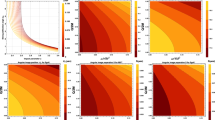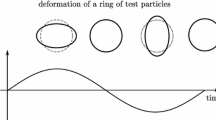APPENDIX A
The metric coefficients of the Kerr–Newman metric are [16]
$${{g}_{{tt}}} = - \left( {1 - \frac{{2Mr - {{Q}^{2}}}}{\Sigma }} \right),\quad {{g}_{{rr}}} = \frac{\Sigma }{\Delta },\quad {{g}_{{\theta \theta }}} = \Sigma ,$$
$${{g}_{{\phi \phi }}} = \frac{{{{{\sin }}^{2}}\theta }}{\Sigma }({{({{r}^{2}} + {{a}^{2}})}^{2}} - \Delta {{a}^{2}}{{\sin }^{2}}\theta ),$$
$${{g}_{{t\phi }}} = - \frac{{(2Mr - {{Q}^{2}})a{{{\sin }}^{2}}\theta }}{\Sigma },\quad {{g}^{{\theta \theta }}} = \frac{1}{\Sigma },$$
$${{g}^{{tt}}} = - \frac{{{{{({{r}^{2}} + {{a}^{2}})}}^{2}} - \Delta {{a}^{2}}{{{\sin }}^{2}}\theta }}{{\Sigma \Delta }},\quad {{g}^{{rr}}} = \frac{\Delta }{\Sigma },$$
$${{g}^{{\phi \phi }}} = \frac{{\Delta - {{a}^{2}}{{{\sin }}^{2}}\theta }}{{\Delta \Sigma {{{\sin }}^{2}}\theta }},\quad {{g}^{{t\phi }}} = - \frac{{(2Mr - {{Q}^{2}})a}}{{\Sigma \Delta }}.$$
The determinant of the metric is [16]
$$g = - {{\Sigma }^{2}}{{\sin }^{2}}\theta .$$
The Christoffel symbols are [16]
$$\Gamma _{{tr}}^{t} = - \frac{{pb}}{\Delta },\quad \Gamma _{{r\phi }}^{t} = \frac{{a{{{\sin }}^{2}}\theta }}{\Delta }(pb + 2qr),$$
$$\Gamma _{{\theta \phi }}^{t} = - \frac{{q{{a}^{3}}}}{\Sigma }{{\sin }^{2}}\theta \sin 2\theta ,\quad \Gamma _{{tt}}^{r} = - \frac{{\Delta p}}{\Sigma },$$
$$\Gamma _{{rr}}^{r} = \frac{r}{\Sigma } + \frac{{M - r}}{\Delta },\quad \Gamma _{{r\theta }}^{r} = - \frac{{{{a}^{2}}\sin 2\theta }}{{2\Sigma }},$$
$$\Gamma _{{\theta \theta }}^{\theta } = - \frac{{{{a}^{2}}\sin 2\theta }}{{2\Sigma }},\quad \Gamma _{{rr}}^{\theta } = \frac{{{{a}^{2}}\sin 2\theta }}{{2\Sigma \Delta }},$$
$$\Gamma _{{\theta \theta }}^{r} = - \frac{{r\Delta }}{\Sigma },\quad \Gamma _{{r\theta }}^{\theta } = \frac{r}{\Sigma },$$
$$\Gamma _{{\phi \phi }}^{r} = - \frac{{\Delta {{{\sin }}^{2}}\theta }}{\Sigma }(r + p{{a}^{2}}{{\sin }^{2}}\theta ),\quad \Gamma _{{t\theta }}^{t} = \frac{{q{{a}^{2}}\sin 2\theta }}{\Sigma },$$
$$\Gamma _{{tt}}^{\theta } = \frac{{q{{a}^{2}}\sin 2\theta }}{{{{\Sigma }^{2}}}},\quad \Gamma _{{t\phi }}^{r} = \frac{{a\Delta p{{{\sin }}^{2}}\theta }}{\Sigma },$$
$$\Gamma _{{t\phi }}^{\theta } = - \frac{{qab\sin 2\theta }}{{{{\Sigma }^{2}}}},\quad \Gamma _{{t\theta }}^{\phi } = \frac{{2qa\cos \theta }}{{\Sigma \sin \theta }},$$
$$\Gamma _{{\phi \phi }}^{\theta } = - \frac{{\sin 2\theta }}{{2\Sigma }}\left[ {b - 2{{a}^{2}}q{{{\sin }}^{2}}\theta \left( {2 + \frac{{{{a}^{2}}{{{\sin }}^{2}}\theta }}{\Sigma }} \right)} \right],$$
$$\Gamma _{{r\phi }}^{\phi } = \frac{r}{\Delta }(1 + 2q)\,\, + \,\,{{a}^{2}}p\frac{{{{{\sin }}^{2}}\theta }}{\Delta },$$
$$\Gamma _{{\theta \phi }}^{\phi } = \frac{{\cos \theta }}{{\Delta \sin \theta }}\left[ {(1 + 2q)(b - 2q{{a}^{2}}{\text{si}}{{{\text{n}}}^{2}}\theta ) - \frac{{2q{{a}^{2}}b{\text{si}}{{{\text{n}}}^{2}}\theta }}{\Sigma }} \right],$$
$$\Gamma _{{tr}}^{\phi } = - a\frac{{r{{Q}^{2}} + M(\Sigma - 2{{r}^{2}})}}{{\Delta {{\Sigma }^{2}}}},$$
where
$$\begin{gathered} b = {{r}^{2}} + {{a}^{2}},\quad p = \frac{{r{{Q}^{2}} + M(\Sigma - 2{{r}^{2}})}}{{{{\Sigma }^{2}}}}, \\ q = \frac{{{{Q}^{2}} - 2Mr}}{{2\Sigma }}. \\ \end{gathered} $$
APPENDIX B
The expression for the radial potential is a quartic algebraic equation, which is convenient to represent as [17]
$$R = (r - {{r}_{a}})(r - {{r}_{b}})(r - {{r}_{c}})(r - {{r}_{d}}),$$
where the roots of the equation are written in decreasing order, ra > rb > rc > rd. The solution of this equation can be written in an explicit form [17] as
$${{r}_{a}} = z + \sqrt { - \frac{\mathcal{A}}{2} - {{z}^{2}} - \frac{\mathcal{B}}{{4z}}} ,$$
$${{r}_{b}} = z - \sqrt { - \frac{\mathcal{A}}{2} - {{z}^{2}} - \frac{\mathcal{B}}{{4z}}} ,$$
$${{r}_{c}} = - z + \sqrt { - \frac{\mathcal{A}}{2} - {{z}^{2}} + \frac{\mathcal{B}}{{4z}}} ,$$
$${{r}_{d}} = - z - \sqrt { - \frac{\mathcal{A}}{2} - {{z}^{2}} + \frac{\mathcal{B}}{{4z}}} ,$$
where
$$\mathcal{A} = {{a}^{2}} - \eta - {{\lambda }^{2}},$$
$$\mathcal{B} = 2M(\eta + {{(\lambda - a)}^{2}}),$$
$$\mathcal{C} = - {{a}^{2}}\eta - {{Q}^{2}}(\eta + {{(a - \lambda )}^{2}}),$$
$$\mathcal{P} = - \frac{{{{A}^{2}}}}{{12}} - \mathcal{C},$$
$$\mathcal{Q} = - \frac{\mathcal{A}}{3}\left[ {{{{\left( {\frac{\mathcal{A}}{6}} \right)}}^{2}} - \mathcal{C}} \right] - \frac{{{{\mathcal{B}}^{2}}}}{8},$$
$${{\omega }_{ \pm }} = \sqrt[3]{{ - \frac{\mathcal{Q}}{2} \pm \sqrt {{{{\left( {\frac{\mathcal{P}}{3}} \right)}}^{3}} + {{{\left( {\frac{\mathcal{Q}}{2}} \right)}}^{2}}} }},$$
$$z = \sqrt {\frac{{{{\omega }_{ + }} + {{\omega }_{ - }}}}{2} - \frac{\mathcal{A}}{6}} > 0.$$
APPENDIX C
The incomplete elliptic integrals of the first, second, and third types are defined as follows:
$$F(\phi ,k) = \int\limits_0^\phi {\frac{{d\theta }}{{\sqrt {1 - k{{{\sin }}^{2}}\theta } }},} $$
$$E(\phi ,k) = \int\limits_0^\phi {\sqrt {1 - k{{{\sin }}^{2}}\theta } d\theta ,} $$
$$\Pi ({{\alpha }^{2}},\phi ,k) = \int\limits_0^\phi {\frac{1}{{1 - {{\alpha }^{2}}{{{\sin }}^{2}}\theta }}} \frac{{d\theta }}{{\sqrt {1 - k{{{\sin }}^{2}}\theta } }}.$$
The derivative of the elliptic integral of the second type E with respect to the parameter k is specified as
$$E{\kern 1pt} '(\phi ,k) = \frac{{\partial E(\phi ,k)}}{{\partial k}} = \frac{{E(\phi ,k) - F(\phi ,k)}}{{2k}}.$$
The complete elliptic integrals are defined by the condition ϕ = π/2 and are designated as
$$K(k) = F(\pi {\text{/}}2,k),\quad E(k) = E(\pi {\text{/}}2,k),$$
$$\Pi (n,k) = \Pi (n,\pi {\text{/}}2,k).$$
Let us introduce the notation
$$\nu = \arcsin \sqrt {\frac{{({{r}_{b}} - {{r}_{d}})(r - {{r}_{a}})}}{{({{r}_{a}} - {{r}_{d}})(r - {{r}_{b}})}}} ,\quad {{\alpha }^{2}} = \frac{{{{r}_{a}} - {{r}_{d}}}}{{{{r}_{b}} - {{r}_{d}}}},$$
$$g = \frac{2}{{\sqrt {({{r}_{a}} - {{r}_{c}})({{r}_{b}} - {{r}_{d}})} }},\quad k = \frac{{({{r}_{b}} - {{r}_{c}})({{r}_{a}} - {{r}_{d}})}}{{({{r}_{a}} - {{r}_{c}})({{r}_{b}} - {{r}_{d}})}}.$$
To calculate the integrals I, we used the following tabulated integrals for the case where r > ra. This integral is calculated in [21]:
$$\int\limits_{{{r}_{a}}}^r {\frac{{dx}}{{\sqrt {(x - {{r}_{a}})(x - {{r}_{b}})(x - {{r}_{c}})(x - {{r}_{d}})} }} = gF(\nu ,k).} $$
This integral is calculated in [21]:
$$\begin{gathered} \int\limits_{{{r}_{a}}}^r {\frac{{xdx}}{{\sqrt {(x - {{r}_{a}})(x - {{r}_{b}})(x - {{r}_{c}})(x - {{r}_{d}})} }}} \\ = g[({{r}_{a}} - {{r}_{b}})\Pi ({{\alpha }^{2}},\nu ,k) + {{r}_{b}}F(\nu ,k)]. \\ \end{gathered} $$
This integral is calculated in [21]:
$$\begin{gathered} \int\limits_{{{r}_{a}}}^r {\frac{{dx}}{{(p - x)\sqrt {(x - {{r}_{a}})(x - {{r}_{b}})(x - {{r}_{c}})(x - {{r}_{d}})} }}} \\ = \frac{g}{{(p - {{r}_{a}})(p - {{r}_{b}})}}\left[ {({{r}_{a}} - {{r}_{b}})\Pi \left( {{{\alpha }^{2}}\frac{{p - {{r}_{b}}}}{{p - {{r}_{a}}}},\nu ,k} \right)} \right. \\ \left. {_{{_{{_{{_{{_{{_{{_{{_{{_{{_{{}}}}}}}}}}}}}}}}}}}} + \,(p - {{r}_{a}})F(\nu ,k)} \right]. \\ \end{gathered} $$
This integral is calculated on page 130 in [22]:
$$\begin{gathered} \int\limits_{{{r}_{a}}}^r {\frac{{{{x}^{2}}dx}}{{\sqrt {(x - {{r}_{a}})(x - {{r}_{b}})(x - {{r}_{c}})(x - {{r}_{d}})} }}} \\ = gr_{a}^{2}\int\limits_0^{{{u}_{1}}} {\frac{{{{{(1 - \alpha _{1}^{2}{\text{s}}{{{\text{n}}}^{2}}u)}}^{2}}}}{{{{{(1 - {{\alpha }^{2}}{\text{s}}{{{\text{n}}}^{2}}u)}}^{2}}}}du} , \\ \end{gathered} $$
where
$${\text{am}}{{u}_{1}} = \arcsin \sqrt {\frac{{({{r}_{b}} - {{r}_{d}})(r - {{r}_{a}})}}{{({{r}_{a}} - {{r}_{d}})(r - {{r}_{b}})}}} ,\quad \alpha _{1}^{2} = \frac{{{{r}_{a}} - {{r}_{d}}}}{{{{r}_{b}} - {{r}_{d}}}}\frac{{{{r}_{b}}}}{{{{r}_{a}}}}$$
and am denotes the amplitude of u1.
This integral is calculated on page 205 in [22]:
$$\begin{gathered} \int {\frac{{{{{(1 - \alpha _{1}^{2}{\text{s}}{{{\text{n}}}^{2}}u)}}^{2}}}}{{{{{(1 - {{\alpha }^{2}}{\text{s}}{{{\text{n}}}^{2}}u)}}^{2}}}}} du \\ = \frac{{\alpha _{1}^{4}}}{{{{\alpha }^{4}}}}\left[ {{{V}_{0}} + 2\frac{{{{\alpha }^{2}} - \alpha _{1}^{2}}}{{\alpha _{1}^{2}}}{{V}_{1}} + \frac{{{{{({{\alpha }^{2}} - \alpha _{1}^{2})}}^{2}}}}{{\alpha _{1}^{4}}}{{V}_{2}}} \right], \\ \end{gathered} $$
where (see page 201 [22])
$${{V}_{0}} = \int {du = F(\nu ,k),} $$
$${{V}_{1}} = \int {\frac{{du}}{{1 - {{\alpha }^{2}}{\text{s}}{{{\text{n}}}^{2}}u}}} = \Pi ({{\alpha }^{2}},\nu ,k),$$
$$\begin{gathered} {{V}_{2}} = \int {\frac{{du}}{{{{{(1 - {{\alpha }^{2}}{\text{s}}{{{\text{n}}}^{2}}u)}}^{2}}}}} \\ = \frac{1}{{2({{\alpha }^{2}} - 1)(k - {{\alpha }^{2}})}}\left[ {{{\alpha }^{2}}E(u) + (k - {{\alpha }^{2}}){{u}_{{_{{_{{_{{_{{_{{_{{_{{_{{_{{}}}}}}}}}}}}}}}}}}}}}} \right. \\ + (2{{\alpha }^{2}}k + 2{{\alpha }^{2}} - {{\alpha }^{4}} - 3k)\Pi ({{\alpha }^{2}},\nu ,k) \\ \left. { - \frac{{{{\alpha }^{4}}{\text{sn}}u{\text{cn}}u{\text{dn}}u}}{{1 - {{\alpha }^{2}}{\text{s}}{{{\text{n}}}^{2}}u}}} \right], \\ \end{gathered} $$
snu, cnu, and dnu are the Jacobi elliptic integrals.
It is easy to represent the integral Iϕ in the form tabulated integrals. For this purpose, let us expand Iϕ as [23]
$$\begin{gathered} {{I}_{\phi }} = \int\limits_{{{r}_{a}}}^r {\frac{{a(2rM - {{Q}^{2}} - a\lambda )}}{{\Delta \sqrt R }}dr} \\ = a\sum\limits_{i = 1}^{i = 2} {\int\limits_{{{r}_{a}}}^r {\frac{{{{K}_{i}}dr}}{{(r - {{r}_{i}})\sqrt R }}} } \\ = ga\sum\limits_{i = 1}^2 {{{\Gamma }_{i}}[(1 - \beta _{i}^{2})\Pi (\nu ,\gamma _{i}^{2},k) + \beta _{i}^{2}F(\nu ,k)],} \\ \end{gathered} $$
where
$$\gamma _{i}^{2} = \frac{{{{r}_{a}} - {{r}_{d}}}}{{{{r}_{b}} - {{r}_{d}}}}\frac{{{{r}_{i}} - {{r}_{b}}}}{{{{r}_{i}} - {{r}_{a}}}},\quad \beta _{i}^{2} = \frac{{{{r}_{i}} - {{r}_{a}}}}{{{{r}_{i}} - {{r}_{b}}}},$$
$${{r}_{i}} = M + {{( - 1)}^{{i + 1}}}\sqrt {{{M}^{2}} - {{a}^{2}} - {{Q}^{2}}} ,\quad {{\Gamma }_{i}} = \frac{{{{K}_{i}}}}{{{{r}_{a}} - {{r}_{i}}}},$$
$${{K}_{i}} = M + {{( - 1)}^{{i + 1}}}\frac{{{{M}^{2}} - {{Q}^{2}}{\text{/}}2 - a\lambda {\text{/}}2}}{{\sqrt {{{M}^{2}} - {{a}^{2}} - {{Q}^{2}}} }},$$
Similarly, let us represent the integral It in the form of tabulated integrals as
$${{I}_{t}} = \int\limits_{{{r}_{a}}}^r {\left[ {\frac{{{{A}_{1}}}}{{r - {{r}_{1}}}} - \frac{{{{A}_{2}}}}{{r - {{r}_{2}}}} + 4{{M}^{2}} - {{Q}^{2}} + 2Mr + {{r}^{2}}} \right]\frac{{dr}}{{_{{ \pm r}}\sqrt R }}} ,$$
where
$${{A}_{1}}({{r}_{1}} - {{r}_{2}}) = (2M{{r}_{1}} - {{Q}^{2}})(r_{1}^{2} + {{a}^{2}} - a\lambda ),$$
$${{A}_{2}}({{r}_{1}} - {{r}_{2}}) = - (2M{{r}_{2}} - {{Q}^{2}})(r_{2}^{2} + {{a}^{2}} - a\lambda ).$$
APPENDIX D
To calculate the visibility function, we used the following tabulated integrals. To calculate the integral (10), we used the tabulated integral
$$\int\limits_0^{2\pi } {{{e}^{{ - 2\pi iu\rho \cos ({{\phi }_{\rho }} - {{\phi }_{u}})}}}d{{\phi }_{\rho }}} = 2\pi {{J}_{0}}(2\pi u\rho ).$$
To calculate the integrals (11)–(13), we used the tabulated integrals (page 484 in [24])
$$\int\limits_0^z {t{{J}_{0}}(ut)dt = \frac{z}{u}{{J}_{1}}(uz),} $$
$$\begin{gathered} \int\limits_0^z {{{t}^{2}}{{J}_{0}}(ut)dt} \\ = \frac{z}{{2{{u}^{2}}}}[2uz{{J}_{1}}(uz) - \pi {{J}_{1}}(uz){{H}_{0}}(uz) + \pi {{J}_{0}}(uz){{H}_{1}}(uz)], \\ \end{gathered} $$
$$\begin{gathered} \int\limits_0^z {{{t}^{3}}{{J}_{0}}(ut)dt = \frac{{{{z}^{2}}}}{{{{u}^{2}}}}(2{{J}_{2}}(uz) - uz{{J}_{3}}(uz))} \\ = \frac{{{{z}^{2}}}}{{{{u}^{2}}}}[uz{{J}_{1}}(uz) - 2{{J}_{2}}(uz)] \\ = \frac{{{{z}^{2}}}}{{{{u}^{2}}}}\left[ {uz{{J}_{1}}(uz) - \frac{4}{{uz}}{{J}_{1}}(uz) + 2{{J}_{0}}(uz)} \right], \\ \end{gathered} $$
where H is the Struve function. To calculate the integral (14), we used the tabulated integral
$$\frac{{2u}}{\pi }\int\limits_0^x {t{{J}_{1}}(ut)dt = x[{{J}_{1}}(ux){{H}_{0}}(ux) - {{J}_{0}}(ux){{H}_{1}}(ux)].} $$








